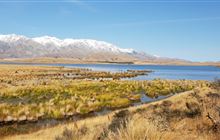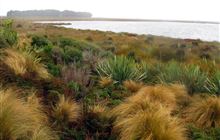Marsh crake/koitareke
Introduction
The at risk Baillon's crake/marsh crake/koitareke is an endemic subspecies which inhabits wetlands throughout New Zealand.New Zealand status: Native
Conservation status: Declining
Found in: Dense wetland vegetation throughout New Zealand, but mainly in the South Island
Threats: Predation, habitat loss
Species information: Marsh crake on NZ Birds Online
Emergency hotline
Call 0800 DOC HOT (0800 362 468) immediately if you see anyone catching, harming or killing native wildlife.
The marsh crake (Porzana pusilla affinis), or koitareke/kotoreke as it is known to Māori, is one of the most secretive New Zealand birds, largely because it inhabits dense wetland vegetation, rarely ventures into the open and usually only calls at dusk and through the night.
These small rails are half the size of the common blackbird but have spectacular plumage. They appear stout or dumpy because of their short tail and relatively long legs for their body size. The upper parts are rich chestnut-brown with flecks of black and white, the under parts are grey with black and white bars towards the flanks, the eye is bright red, the beak green and the legs olive. Very little is known of their ecology.
Marsh crakes have declined dramatically since humans began draining wetlands and are now classed as At-Risk Declining.
Where are they found?
Baillon's crake consists of at least five subspecies globally - affinis in New Zealand, palustris in Australia and Papua New Guinea, mira in Borneo, pusilla through the Palearctic to Asia and intermedia in Africa.
In New Zealand, marsh crakes have been recorded throughout the country but the majority of records are in the South Island where they appear to be more numerous.
They have been recorded in a wide variety of inland and coastal wetland types, particularly Carex secta and raupo (Typha orientalis) swamps.
Also recorded from estuarine reed beds and sometime wet but modified pasture and willow-woodlands.
We don’t have a thorough understanding of the most important sites nationally for marsh crake. But, coastal inlets of Tasman, Nelson and Marlborough, the Ashburton Lakes (Ō Tū Wharekai wetland) and Te Waihora/Lake Ellesmere and other coastal sites in Canterbury and the Awarua-Waituna wetland complex in Southland are known hotspots.
Quick facts
- Marsh crakes are small water birds (15-18 cm, 30-40 g). They are rarely seen and their population numbers are unknown.
- The crown, upper parts and wings are rich chestnut-brown with flecks and streaks of black and white, the face and under parts are grey with black and white bars towards the flanks and vent. The eye is bright red, the beak green and the legs olive or yellowish-olive. Both sexes have similar plumage although the female is said to be duller. Juveniles are similar but have buff-brown instead of grey underparts.
- Little is known of marsh crake behaviour and ecology. They are very secretive and most conspicuous from their calls at night in spring and early summer. Marsh crakes may migrate locally, as other subspecies do overseas.
- Marsh crake's territorial and courtship calls can make them conspicuous in spring, but they generally only call at night. A range of calls includes: "Kreeek", "Trrrrrrr" (combing), "Krakrakra-gagaga" and "Krehehehe".
- Marsh crakes are monogamous and breeding occurs deep in wetlands. Aerial courtship flights occur at night. Nesting occurs between September and December. The nest cup consists of woven grasses generally concealed under sedges or dense reeds in water. The female lays 5-7 olive-brown eggs. Both sexes incubate and incubation takes 16-20 days. Chicks are covered with black down when they hatch.
- Marsh crake primarily feed on invertebrates and seeds of aquatic plants.
- They are a potential indicator of wetland health because they are dependent on the presence of high quality and ecologically diverse habitats and rich food supplies.
- Similar species: spotless crake (general dark plumage and red eye) and banded rail (much larger).
Threats
The main threats to marsh crake/koitareke are:
- Habitat clearance and drainage has had a significant impact on marsh crake. Over 90% of lowland freshwater wetlands have been drained and cleared for agriculture since Europeans settled New Zealand. Degradation of the remaining wetlands continues with grazing, water pollution and taking of water for other uses being major threats.
- Continued habitat modification including the loss of food supplies.
- Predation by introduced mammals such as cats, dogs, mustelids and rats. Cats appear to be a significant threat to marsh crake, based on historic and current data.
Other factors which impact on the marsh crake/koitareke:
- Road-kills and flying into power lines are also causes of death.
- Nesting crakes are sensitive to disturbance by humans.
Our work
Wetlands support a wide range of threatened bird species in New Zealand. However, management techniques for restoring their populations are poorly developed.
DOC is focusing on developing methods for surveying marsh crakes systematically. These methods will enable people to establish baseline data and distribution maps; identify important wetland habitat types for conservation and measure the response to management such as pest control; and habitat maintenance and restoration.
DOC has been developing ‘call counts' for marsh crakes. These take place with either an observer listening for set times at dawn or dusk using call lures, or with new automatic recorders (electronic recorders developed by the DOC Electronics Lab) recording calls remotely.
In addition DOC is actively developing methods for restoring wetlands through its Arawai Kākāriki Programme. Restoration involves developing a wide range of management tools including methods for controlling introduced predators, methods for managing water levels and restoring wetland vegetation.
You can help
Report all sightings or calls of marsh crakes to your nearest DOC office.



